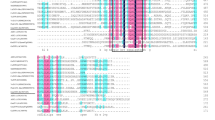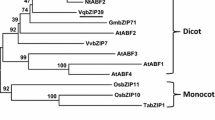Abstract
The basic leucine zipper (bZIP) transcription factors (TFs) function as regulators of many key developmental and physiological processes in all eukaryotes. In this study, we characterized the function of Arabidopsis bZIP4, a group S bZIP, whose function was not known. We confirmed that bZIP4 localizes to the nucleus and has DNA-binding affinity. By qRT-PCR and GUS histochemical analysis, we showed that bZIP4 is specifically expressed in root and that its expression is induced by abiotic stress and ABA. By phenotypic analysis, we demonstrated that the root length and the germination rate of bZIP4 overexpression (bZIP4-Ox) were significantly longer and higher than those of the WT and bZIP4-SRDX under higher salt and glucose concentrations, indicating that bZIP4-Ox is insensitive and tolerant to abiotic stress. Despite that, we found that bZIP4-Ox had enhanced expression of genes encoding protein phosphatases suppressing ABA responsiveness. We also confirmed that bZIP4 interacts with CaM1 and showed that its DNA-binding affinity is inhibited by interaction with CaM1. We propose a model in which the increased cytosolic calcium concentration under stress conditions activates CaM1 to bind bZIP4 to remove it from promoters of genes encoding ABA negative regulators, allowing the plants to operate on a typical ABA signaling pathway.







Similar content being viewed by others
Abbreviations
- ABA:
-
Abscisic acid
- BiFC:
-
Bimolecular fluorescence complementation
- bZIP4:
-
Basic region leucine zipper protein 4
- CaM1:
-
Calmodulin1
- CAMTA:
-
CaM-binding transcription activator
- GFP:
-
Green fluorescence protein
- GST:
-
Glutathione S-transferase
- GUS:
-
Beta-glucuronidase
- His:
-
Poly-histidine
- K.O:
-
Knock-out
- MS medium:
-
Murashige and skoog medium
- Ox:
-
Overexpression
- qRT-PCR:
-
Quantitative real-time reverse transcription-polymerase chain reaction
- RT-PCR:
-
Reverse transcription-PCR
- TF:
-
Transcription factor
- WT:
-
Wild type
- X-gluc:
-
5-Bromo-4-chloro-3-indolyl glucuronide
- YFP:
-
Yellow fluorescence protein
References
Abe H, Yamaguchi-Shinozaki K, Urao T, Iwasaki T, Hosokawa D, Shinozaki K (1997) Role of arabidopsis MYC and MYB homologs in drought-and abscisic acid-regulated gene expression. Plant Cell 9:1859–1868
Arenas-Huertero F, Arroyo A, Zhou L, Sheen J, Leon P (2000) Analysis of Arabidopsis glucose insensitive mutants, gin5 and gin6, reveals a central role of the plant hormone ABA in the regulation of plant vegetative development by sugar. Genes Dev 14:2085–2096
Banerjee A, Roychoudhury A (2017) Abscisic-acid-dependent basic leucine zipper (bZIP) transcription factors in plant abiotic stress. Protoplasma 254:3–16
Clapham DE (2007) Calcium signaling. Cell 131:1047–1058
Clough SJ, Bent AF (1998) Floral dip: a simplified method for Agrobacterium-mediated transformation of Arabidopsis thaliana. Plant J 16:735–743
Cui MH, Yoo KS, Hyoung S, Nguyen HT, Kim YY, Kim HJ, Ok SH, Yoo SD, Shin JS (2013) An Arabidopsis R2R3-MYB transcription factor, AtMYB20, negatively regulates type 2C serine/threonine protein phosphatases to enhance salt tolerance. FEBS Lett 587:1773–1778
Deger AG, Scherzer S, Nuhkat M, Kedzierska J, Kollist H, Brosché M, Unyayar S, Boudsocq M, Hedrich R, Roelfsema MRG (2015) Guard cell SLAC1-type anion channels mediate flagellin-induced stomatal closure. New Phytol 208:162–173
Dekkers BJ, Schuurmans JA, Smeekens SC (2008) Interaction between sugar and abscisic acid signalling during early seedling development in Arabidopsis. Plant Mol Biol 67:151–167
Doherty CJ, Van Buskirk HA, Myers SJ, Thomashow MF (2009) Roles for Arabidopsis CAMTA transcription factors in cold-regulated gene expression and freezing tolerance. Plant Cell 21:972–984
Droge-Laser W, Weiste C (2018) The C/S1bZIP network: a regulatory hub orchestrating plant energy homeostasis. Trends Plant Sci 23:422–433
Droge-Laser W, Snoek BL, Snel B, Weiste C (2018) The Arabidopsis bZIP transcription factor family-an update. CurrOpin Plant Biol 45:36–49
Edel KH, Kudla J (2016) Integration of calcium and ABAsignaling. CurrOpin Plant Biol 33:83–91
Ehlert A, Weltmeier F, Wang X, Mayer CS, Smeekens S, Vicente-Carbajosa J, Droge-Laser W (2006) Two-hybrid protein-protein interaction analysis in Arabidopsis protoplasts: establishment of a heterodimerization map of group C and group S bZIP transcription factors. Plant J 46:890–900
Finkelstein RR, Gampala SS, Rock CD (2002) Abscisic acid signaling in seeds and seedlings. Plant Cell 14(Suppl):S15-45
Fujita Y, Fujita M, Shinozaki K, Yamaguchi-Shinozaki K (2011) ABA-mediated transcriptional regulation in response to osmotic stress in plants. J Plant Res 124:509–525
Gao S, Gao J, Zhu X, Song Y, Li Z, Ren G, Zhou X, Kuai B (2016) ABF2, ABF3, and ABF4 promote ABA-mediated chlorophyll degradation and leaf senescence by transcriptional activation of chlorophyll catabolic genes and senescence-associated genes in arabidopsis. Mol Plant 9:1272–1285
Hartmann L, Pedrotti L, Weiste C, Fekete A, Schierstaedt J, Gottler J, Kempa S, Krischke M, Dietrich K, Mueller MJ et al (2015) Crosstalk between Two bZIPsignaling pathways orchestrates salt-induced metabolic reprogramming in arabidopsis roots. Plant Cell 27:2244–2260
Hong JH, Seah SW, Xu J (2013) The root of ABA action in environmental stress response. Plant Cell Rep 32:971–983
Huang S, Waadt R, Nuhkat M, Kollist H, Hedrich R, Roelfsema MRG (2019) Calcium signals in guard cells enhance the efficiency by which abscisic acid triggers stomatal closure. New Phytol 224:177–187
Iuchi S, Kobayashi M, Taji T, Naramoto M, Seki M, Kato T, Tabata S, Kakubari Y, Yamaguchi-Shinozaki K, Shinozaki K (2001) Regulation of drought tolerance by gene manipulation of 9-cis-epoxycarotenoid dioxygenase, a key enzyme in abscisic acid biosynthesis in Arabidopsis. Plant J 27:325–333
Izawa T, Foster R, Chua NH (1993) Plant bZIP protein DNA binding specificity. J Mol Biol 230:1131–1144
Jakoby M, Weisshaar B, Droge-Laser W, Vicente-Carbajosa J, Tiedemann J, Kroj T, Parcy F, B Z I P R G (2002) bZIP transcription factors in Arabidopsis. Trends Plant Sci 7: 106–11
Kang SG, Price J, Lin PC, Hong JC, Jang JC (2010) The arabidopsis bZIP1 transcription factor is involved in sugar signaling, protein networking, and DNA binding. Mol Plant 3:361–373
Kim YY, Cui MH, Noh MS, Jung KW, Shin JS (2017) The FBA motif-containing protein AFBA1 acts as a novel positive regulator of ABA response in Arabidopsis. Plant Cell Physiol 58:574–586
Koncz C, Schell J (1986) The promoter of TL-DNA gene 5 controls the tissue-specific expression of chimaeric genes carried by a novel type of Agrobacterium binary vector. Mol Gen Genet MGG 204:383–396
Kudla J, Batistic O, Hashimoto K (2010) Calcium signals: the lead currency of plant information processing. Plant Cell 22:541–563
Leung J, Merlot S, Giraudat J (1997) The Arabidopsis ABSCISIC ACID-INSENSITIVE2 (ABI2) and ABI1 genes encode homologous protein phosphatases 2C involved in abscisic acid signal transduction. Plant Cell 9:759–771
Levchenko V, Konrad KR, Dietrich P, Roelfsema MRG, Hedrich R (2005) Cytosolic abscisic acid activates guard cell anion channels without preceding Ca2+ signals. Proc Natl Acad Sci 102:4203–4208
Mahfouz MM, Li L, Piatek M, Fang X, Mansour H, Bangarusamy DK, Zhu JK (2012) Targeted transcriptional repression using a chimeric TALE-SRDX repressor protein. Plant Mol Biol 78:311–321
Maierhofer T, Diekmann M, Offenborn JN, Lind C, Bauer H, Hashimoto K, Ka S a-R, Luan S, Kudla J, Geiger D, et al. (2014) Site- and kinase-specific phosphorylation-mediated activation of SLAC1, a guard cell anion channel stimulated by abscisic acid. Sci Signal 7: ra86
Murashige T, Skoog F (1962) A revised medium for rapid growth and bio assays with tobacco tissue cultures. Physiol Plant 15:473–497
Nguyen HT, Kim SY, Cho KM, Hong JC, Shin JS, Kim HJ (2016) A transcription factor gammaMYB1 binds to the P1BS cis-element and activates PLA2-gamma expression with its co-activator gammaMYB2. Plant Cell Physiol 57:784–797
Popescu SC, Popescu GV, Bachan S, Zhang Z, Seay M, Gerstein M, Snyder M, Dinesh-Kumar SP (2007) Differential binding of calmodulin-related proteins to their targets revealed through high-density Arabidopsis protein microarrays. Proc Natl Acad Sci USA 104:4730–4735
Ranty B, Aldon D, Galaud JP (2006) Plant calmodulins and calmodulin-related proteins: multifaceted relays to decode calcium signals. Plant Signal Behav 1:96–104
Reddy AS, Ali GS, Celesnik H, Day IS (2011) Coping with stresses: roles of calcium- and calcium/calmodulin-regulated gene expression. Plant Cell 23:2010–2032
Rodrigues A, Adamo M, Crozet P, Margalha L, Confraria A, Martinho C, Elias A, Rabissi A, Lumbreras V, Gonzalez-Guzman M et al (2013) ABI1 and PP2CA phosphatases are negative regulators of Snf1-related protein kinase1signaling in Arabidopsis. Plant Cell 25:3871–3884
Snedden WA, Fromm H (1998) Calmodulin, calmodulin-related proteins and plant responses to the environment. Trends Plant Sci 3:299–304
Song YH, Yoo CM, Hong AP, Kim SH, Jeong HJ, Shin SY, Kim HJ, Yun DJ, Lim CO, Bahk JD et al (2008) DNA-binding study identifies C-box and hybrid C/G-box or C/A-box motifs as high-affinity binding sites for STF1 and LONG HYPOCOTYL5 proteins. Plant Physiol 146:1862–1877
Sun LR, Wang YB, He SB, Hao FS (2018) Mechanisms for abscisic acid inhibition of primary root growth. Plant Signal Behav 13:e1500069
Tan W, Zhang D, Zhou H, Zheng T, Yin Y, Lin H (2018) Transcription factor HAT1 is a substrate of SnRK2.3 kinase and negatively regulates ABA synthesis and signaling in Arabidopsis responding to drought. PLoS Genet 14: e1007336
Umezawa T, Nakashima K, Miyakawa T, Kuromori T, Tanokura M, Shinozaki K, Yamaguchi-Shinozaki K (2010) Molecular basis of the core regulatory network in ABA responses: sensing, signaling and transport. Plant Cell Physiol 51:1821–1839
Vishwakarma K, Upadhyay N, Kumar N, Yadav G, Singh J, Mishra RK, Kumar V, Verma R, Upadhyay RG, Pandey M et al (2017) Abscisic acid signaling and abiotic stress tolerance in plants: a review on current knowledge and future prospects. Front Plant Sci 8:161
Wang H, Datla R, Georges F, Loewen M, Cutler AJ (1995) Promoters from kin1 and cor6.6, two homologous Arabidopsis thaliana genes: transcriptional regulation and gene expression induced by low temperature, ABA, osmoticum and dehydration. Plant Mol Biol 28:605–617
Weiste C, Droge-Laser W (2014) The Arabidopsis transcription factor bZIP11 activates auxin-mediated transcription by recruiting the histone acetylation machinery. Nat Commun 5:3883
Weiste C, Pedrotti L, Selvanayagam J, Muralidhara P, Froschel C, Novak O, Ljung K, Hanson J, Droge-Laser W (2017) The Arabidopsis bZIP11 transcription factor links low-energy signalling to auxin-mediated control of primary root growth. PLoS Genet 13:e1006607
Yoo JH, Park CY, Kim JC, Heo WD, Cheong MS, Park HC, Kim MC, Moon BC, Choi MS, Kang YH et al (2005) Direct interaction of a divergent CaM isoform and the transcription factor, MYB2, enhances salt tolerance in arabidopsis. J Biol Chem 280:3697–3706
Zhang J, Jia W, Yang J, Ismail AM (2006) Role of ABA in integrating plant responses to drought and salt stresses. Field Crop Res 97:111–119
Zhang Q, Kong X, Yu Q, Ding Y, Li X, Yang Y (2019) Responses of PYR/PYL/RCARABA receptors to contrasting stresses, heat and cold in arabidopsis. Plant Signal Behav 14:1670596
Zhou YP, Wu JH, Xiao WH, Chen W, Chen QH, Fan T, Xie CP, Tian CE (2018) Arabidopsis IQM4, a novel calmodulin-binding protein, is involved with seed dormancy and germination in arabidopsis. Front Plant Sci 9:721
Funding
This work was supported by the National Research Foundation of Korea (NRF) Grant (2019R1F1A1060014) funded by the Ministry of Science and ICT, Korea government. This work was also partially supported by Korea University.
Author information
Authors and Affiliations
Contributions
Conceptualization, YYK, KWJ and JSS; validation, YYK and KWJ; formal analysis, YYK, MN and AKMMH; investigation, YYK, MN and AKMMH; writing–original draft preparation, MN; writing–review and editing, MN and JSS; supervision, YYK, and JSS; project administration and funding acquisition, JSS. All authors have read and agreed to the published version of the manuscript.
Corresponding authors
Ethics declarations
Conflict of Interest
The authors declare no conflicts of interest.
Supplementary Information
Below is the link to the electronic supplementary material.
Rights and permissions
About this article
Cite this article
Noh, M., Huque, A.K.M.M., Jung, K.W. et al. A Stress-Responsive CaM-Binding Transcription Factor, bZIP4, Confers Abiotic Stress Resistance in Arabidopsis. J. Plant Biol. 64, 359–370 (2021). https://doi.org/10.1007/s12374-021-09315-4
Received:
Revised:
Accepted:
Published:
Issue Date:
DOI: https://doi.org/10.1007/s12374-021-09315-4




